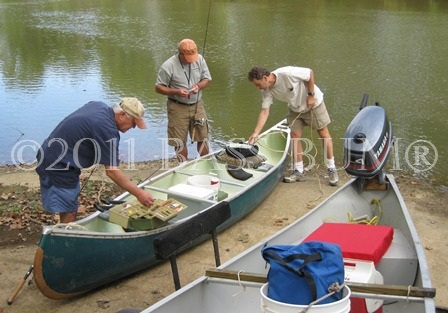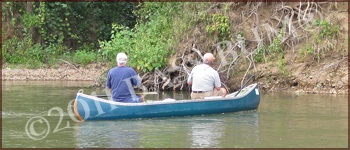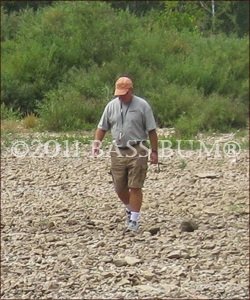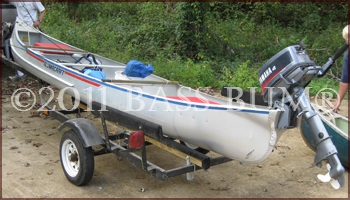Canoe Fishing is River Bass Fishing

Canoe Fishing Alone or With Buddies
Either Way It's a Completely Different Experience Than Big Water Fishing

In summertime, if you don't night fish, you probably wish you could go where there are no pleasure boaters, jet skiers or fishing tournaments that plague the big water. Canoe fishing country streams and small rivers will transport you to a world of quite tranquility surrounded by nature. No jet skiers here. Just you and the deer, kingfishers, eagles, otters, beaver, turkey and foxes. Oh, and did I say,river smallmouth bass? Spots and largemouth bass too.
I spend most of my time on big waters chasing smallies and big mouth bass in my Triton. But in the summer when the temperature is too much for this old man and the mass of "summer people" clog the lakes churning the water into a froth I head to where I can do some clear water river fishing, the many streams and creeks found in Tennessee.
Fishing Canoes, Jon Boats or Kayaks?
Now there are several type of river fishing boats or watercraft that one could use on a stream or small river. Besides a fishing canoe one could choose from a wide choice of jon boats or kayaks for fishing. They all have their pros and cons. I fish from all of them but in very different situations.
Jon boats are best used on larger rivers and small lakes. At least that's where I use them to best advantage. But they aren't the easiest to maneuver if you find yourself in tight quarters. They are fairly stable due to the flat bottom.
However, they are a bit difficult to control with a paddle if the wind is up. Outfitting them with a trolling motor or small gas powered motor proves very beneficial.

Where canoes shine are for fishing streams like those found in Tennessee where "run-and-gun" fishing is the preferred technique. Here the anatomy of a stream is a continual change from pool to runs and riffles including current breaks and eddies and then another pool.
We Bass Bum's® float the faster water stopping at gravel bars. Here we we beach our canoes then walk or wade to a position just ahead of the pool that allows us to fish these holes found below riffles. This allows us to approach the pools without spooking any smallmouth that may be waiting there for their next meal. The best bass will most often locate at the tail of the pool, where the water runs out of the pool.

Unfortunately, not all pools will hold bass. As sadly evidenced in the picture of "Mitch" at right as he returns to his canoe empty handed. What we call, the Bass Bum® walk of shame.
Kayaks are another type of watercraft that can be used for bass fishing streams. At least those that are characterized by consistently deeper water.
If you don't fancy a wet butt and sometimes fish in cold weather, and thus cold water, you might not find kayaks your favorite skinny water fishing craft. Additionally, continually getting in and out of a kayak is akin to standing up from sitting on the floor, not a chair. Old and fat? Can't rotate 180° at the waist to get gear behind you? You won't like them.
Having said the above, kayaks are pretty slick if you enjoy solo fishing and want to feel one with nature. I've never figured out how to stay dry without wearing my waders.
We'll cover both Jon boats and kayaks in other pages of this site.
What About Canoe Size, Design? How Heavy Are They?
Not all canoes are good fishing platforms. A canoe between 13' and 16' in length is good for bass fishing streams. As for width, generally speaking, the wider it is the more stable it is. Wider is better for a fishing canoe. It should have a keel and sufficient "rocker" (end-to-end curvature) for increased stability. A square stern also contributes to stability, an important feature for an old guy like me, and accommodates the easy addition of a small outboard motor.
Canoes are made from wood and aluminum. Those made of wood are not only functional but often real works of art and priced accordingly. Heavy too. This is a problem when canoe fishing skinny water where there is often a need to drag or carry a canoe across gravel bars or extensive riffles.

Aluminum canoes are also heavy. Plus they're noisy, which is not good when stealth is so important. River smallmouth are extremely wary and clear water not only makes them more so but enables them to see you before you see them. You come clanging down stream bumping small boulders and scrapping across shallow gravel bars in an aluminum canoe and they'll sure as hell know your coming.
Another issue with aluminum bodies. I swear there is some mysterious attraction between an aluminum canoe and common river stones. They're drawn to and stick to one another like cockleburs and pants legs.
Fishing canoes are also made with bodies of Kevlar, foam covered with polyethylene, fiberglass and foam sandwiched between layers of vinyl and plastic. These materials produce canoes that are strong, abrasion resistant and lightweight and make canoe fishing streams and small rivers even more pleasurable.

Bass Fishing Accessories for Fishing Canoes
A few, of numerous, things one shouldn't be without when canoe fishing:
- First, don't forget a paddle! A back up paddle too.
- Secondly, at least one anchor, though two is better.
- Third the angler should also place all items that would suffer in the event they found their unfortunate way into the water in waterproof bags. These are inexpensive and give a quick return on investment the first time you tip over and your camera, wallet, watch, cell phone and lunch remain dry due to being in waterproof canvas boat bags.
- Fourth, a rod rack of some sort makes life easier.
- Lastly,if you engage in "run-and-gun" fishing while stream fishing a vest with as many pockets as possible comes in mighty handy.
Canoe Fishing on Streams Calls for Downsized Tackle
Though many will tell you that ultralight fishing tackle is the way to go when stream fishing, rods that are light or better yet, medium light, will reduce missed hook sets. A rod that is 5' 6" to 6' in length will enable accurate casting to the banks and fewer limb hangups in tighter quarters.
As for line, I've never been one to use 4lb test for bass. When canoe fishing a creek or stream 6lb or 8lb line gives me more confidence. Some argue my strike ratio is less because the heavier line is more visible to extremely wary smallmouth that live in clear water. Perhaps, but it does me no good to hook up just to be broken off.
For reference, I use three rods when canoe fishing. A 5'6" MF, a
6' LF and a 6' MLF. All three are St.Croix spinning rods that I couple
with a Symetre 2500FJ, a Shimano Symetre 1000FJ, and ABU Garcia Cardinal
500 ALBI spinning reel.
What About River Fishing Lures? Downsize Them Too?
Fish that live in current must eat more and more often than big water bass. They expend significantly more energy fighting the current that lake bass do. Consequently, they'll eat just about anything if the opportunity arises. Nevertheless, smaller lures seem to draw more strikes than do larger ones.
When canoe fishing small spinnerbaits (fished with the current only), in-line spinners, crankbaits (fished cross current), grubs, plastic lizards, tubes and other crayfish imitators will catch river bass.
Return to Bass Fishing and Catching from Canoe Fishing
